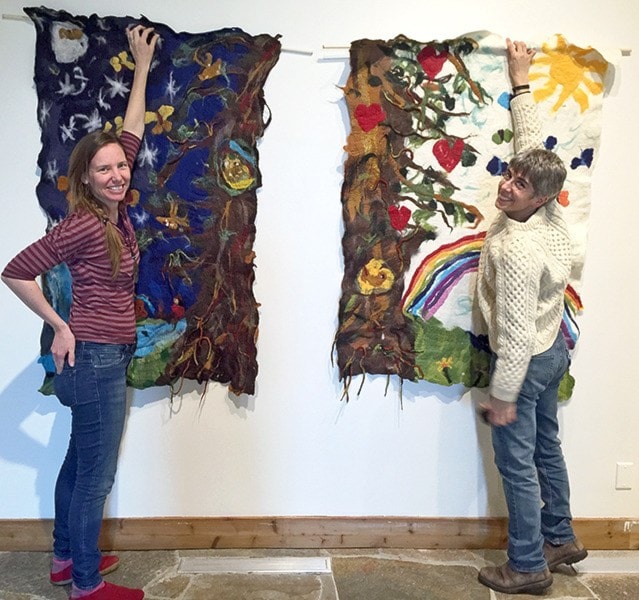An art show opening today at the Haida Gwaii Museum explores a topic rarely seen outside clinics, care homes and hospitals.
Called ’SICK,’ the group show is a unique, interactive take on illness and healing. Kiki van der Heiden is one of the 11 islands artists who contributed to the show, a list that includes a poet, a videographer and several graphic artists, one of whom is a cartoonist who doubles as a family doctor.
“It’s been really wonderful,” says van der Heiden, who is contributing two art pieces as well as a healing meditation and gong bath on April 22 — one of five live events that run in tandem with the show.
Fans of the children’s book Taan’s Moons, which van der Heiden illustrated together with Haida Gwaii schoolchildren, will enjoy the two felted wall-hangings she brought to this show.
Called “healing trees,” they were made with help from Grade 1 and Kindergarten students at Sk’aadgaa Naay Elementary.
Van der Heiden also submitted a more personal work — a series of figures called The Little Girls that reflects on her own experience with illness. In making the figures, and getting to know other artists involved in the project, van der Heiden gained insight into her own healing.
“It’s not helpful to be put in a box,” she said, talking about the way people often get labelled by whatever medical condition they have, and are left to deal with it largely by themselves.
“By sharing, it becomes a little more normal — ‘Oh, you had that as well?’” she said. “It was quite a help.”
Van der Heiden said the idea for the show began with Caroline Shooner, a family doctor in Queen Charlotte who was looking for a broader community perspective on illness and healing.
A group of artists began meeting once a month in April 2014, first to swap stories over potluck dinners, then to join in creative exercises.
When it came time to actually stage an exhibit, van der Heiden said they had to find a way to pull together a diverse range of work, and settled on a kind of illness journey. Visitors begin in a waiting room, then move to clinic, a psychiatric “safe room,” a sanctuary, then a living room — a tour that looks at illness and healing in and out of medical settings.
That is a welcome shift for Caroline Shooner.
As a family doctor, Shooner said there is often too little time to talk with patients about their experience, or to reflect on its deeper meaning.
“You go home, you hit the pillow, and you wake up and start all over again — you never have a pause,” she said, echoing a theme often seen in The Boon Docs, Shooner’s online comic about being a doctor in a small town.
But it’s the big ideas behind medicine — the frailty of the body, mortality, even the purpose of life — that brought Shooner into medicine in the first place.
“These big, philosophical questions really enter the day-to-day in medicine,” she said.
“Every day you’re interacting with people at pivotal moments in their lives.”
Shooner considered philosophy before she went into medicine, then spent years doing short-term contracts so she could tour with Her Sweet Time — a folk duo in which she played banjo, guitar, and sang harmonies.
Since settling on Haida Gwaii in 2007, Shooner has found more ways besides her comics to get a big-picture take on medicine—last year she did a Master’s in Medical Humanities at King’s College, London.
In one class, Shooner did reflective writing — exercises that have since inspired her to lead a writing workshop for healthcare practitioners here on island.
Asked to quickly write positive and negative words about her work, Shooner came up two big ones: ‘mystery’ and ‘doubt.’
“One of the things I find challenging is the uncertainty of medical practice,” she said.
“There are many puzzles — whether it’s how someone might react to a given treatment, or how an illness might progress.”
On the other hand, she said, that same uncertainty can be awe-inspiring.
“I don’t like black-and-white things — they make me a little nervous,” she said.
“Things are always more complicated than they seem, and that’s medicine, for sure.”
